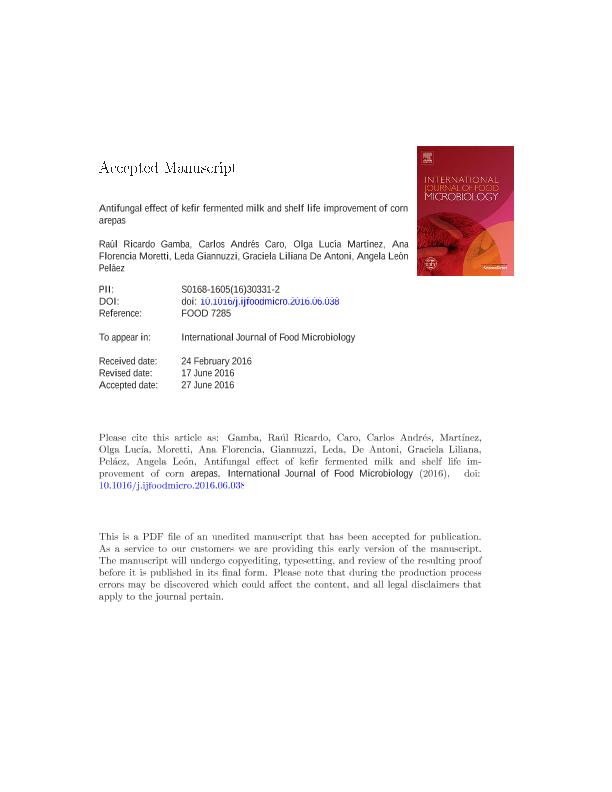Mostrar el registro sencillo del ítem
dc.contributor.author
Gamba, Raul Ricardo

dc.contributor.author
Caro, Carlos Andrés
dc.contributor.author
Martínez, Olga Lucía
dc.contributor.author
Moretti, Ana Florencia

dc.contributor.author
Giannuzzi, Leda

dc.contributor.author
de Antoni, Graciela Liliana

dc.contributor.author
León Peláez, Angela María

dc.date.available
2018-08-27T16:13:08Z
dc.date.issued
2016-10
dc.identifier.citation
Gamba, Raul Ricardo; Caro, Carlos Andrés; Martínez, Olga Lucía; Moretti, Ana Florencia; Giannuzzi, Leda; et al.; Antifungal effect of kefir fermented milk and shelf life improvement of corn arepas; Elsevier Science; International Journal of Food Microbiology; 235; 10-2016; 85-92
dc.identifier.issn
0168-1605
dc.identifier.uri
http://hdl.handle.net/11336/57193
dc.description.abstract
Fungal contamination negatively affects the production of cereal foods such as arepa loaf, an ancient corn bread consumed daily in several countries of Latin-America. Chemical preservatives such as potassium sorbate are applied in order to improve the arepa's shelf life and to reduce the health risks. The use of natural preservatives such as natural fermented products in food commodities is a common demand among the consumers. Kefir is a milk fermented beverage obtained by fermentation of kefir grains. Its antibacterial and probiotic activity has been exhaustively demonstrated. Our objectives were to determine the antifungal effect of kefir fermented milk on Aspergillus flavus AFUNL5 in vitro and to study if the addition of kefir fermented milk to arepas could produce shelf life improvement. We determined the antifungal effect on solid medium of kefir cell-free supernatants (CFS) obtained under different fermentation conditions. Additionally, we compared the antifungal effect of kefir CFS with that obtained with unfermented milk artificially acidified with lactic plus acetic acids (lactic and acetic acids at the same concentration determined in kefir CFS) or with hydrochloric acid. Finally, kefir was added to the corn products either in the loaf recipe (kefir-baked arepas) or sprayed onto the baked-loaf surface (kefir-sprayed arepas). The loaves' resistance to natural and artificial fungal contamination and their organoleptic profiles were studied. The highest fungal inhibition on solid medium was achieved with kefir CFS produced by kefir grains CIDCA AGK1 at 100 g/L, incubated at 30 °C and fermented until pH 3.3. Other CFS obtained from different fermentation conditions achieved less antifungal activity than that mentioned above. However, CFS of milk fermented with kefir grains, until pH 4.5 caused an increase of growth rates. Additionally, CFS produced by kefir grains CIDCA AGK1 at 100 g/L, incubated at 30 °C and fermented until pH 3.3 achieved higher antifungal activity than CFS from artificially acidified milk with organic acids (CFS L + A) at the same concentration of kefir CFS. Besides, CFS from milk acidified with hydrochloric acid (CFS HCl) showed no fungal inhibition. On the other hand, kefir-baked arepas exhibited significant resistance to natural and artificial fungal contamination. Finally, both kefir-baked and kefir-sprayed arepas retained the organoleptic characteristics of the traditional corn product, but with certain tastes imparted by the kefir fermentation. This work constitutes the first study on fungal inhibition by kefir-fermented milk extending to the protection of corn products of mass-consumption and the possible application as a food preservative.
dc.format
application/pdf
dc.language.iso
eng
dc.publisher
Elsevier Science

dc.rights
info:eu-repo/semantics/openAccess
dc.rights.uri
https://creativecommons.org/licenses/by-nc-nd/2.5/ar/
dc.subject
Antifungal
dc.subject
Arepa
dc.subject
Aspergillus Flavus
dc.subject
Kefir
dc.subject
Organoleptic Profile
dc.subject.classification
Alimentos y Bebidas

dc.subject.classification
Otras Ingenierías y Tecnologías

dc.subject.classification
INGENIERÍAS Y TECNOLOGÍAS

dc.title
Antifungal effect of kefir fermented milk and shelf life improvement of corn arepas
dc.type
info:eu-repo/semantics/article
dc.type
info:ar-repo/semantics/artículo
dc.type
info:eu-repo/semantics/publishedVersion
dc.date.updated
2018-08-27T14:00:15Z
dc.journal.volume
235
dc.journal.pagination
85-92
dc.journal.pais
Países Bajos

dc.journal.ciudad
Amsterdam
dc.description.fil
Fil: Gamba, Raul Ricardo. Provincia de Buenos Aires. Gobernación. Comisión de Investigaciones Científicas. Centro de Investigación y Desarrollo en Criotecnología de Alimentos. Consejo Nacional de Investigaciones Científicas y Técnicas. Centro Científico Tecnológico Conicet - La Plata. Centro de Investigación y Desarrollo en Criotecnología de Alimentos. Universidad Nacional de La Plata. Facultad de Ciencias Exactas. Centro de Investigación y Desarrollo en Criotecnología de Alimentos; Argentina. Universidad Nacional de La Plata. Facultad de Ciencias Exactas; Argentina
dc.description.fil
Fil: Caro, Carlos Andrés. Universidad de Antioquia; Colombia
dc.description.fil
Fil: Martínez, Olga Lucía. Universidad de Antioquia; Colombia
dc.description.fil
Fil: Moretti, Ana Florencia. Provincia de Buenos Aires. Gobernación. Comisión de Investigaciones Científicas. Centro de Investigación y Desarrollo en Criotecnología de Alimentos. Consejo Nacional de Investigaciones Científicas y Técnicas. Centro Científico Tecnológico Conicet - La Plata. Centro de Investigación y Desarrollo en Criotecnología de Alimentos. Universidad Nacional de La Plata. Facultad de Ciencias Exactas. Centro de Investigación y Desarrollo en Criotecnología de Alimentos; Argentina
dc.description.fil
Fil: Giannuzzi, Leda. Provincia de Buenos Aires. Gobernación. Comisión de Investigaciones Científicas. Centro de Investigación y Desarrollo en Criotecnología de Alimentos. Consejo Nacional de Investigaciones Científicas y Técnicas. Centro Científico Tecnológico Conicet - La Plata. Centro de Investigación y Desarrollo en Criotecnología de Alimentos. Universidad Nacional de La Plata. Facultad de Ciencias Exactas. Centro de Investigación y Desarrollo en Criotecnología de Alimentos; Argentina. Universidad Nacional de La Plata. Facultad de Ciencias Exactas; Argentina
dc.description.fil
Fil: de Antoni, Graciela Liliana. Provincia de Buenos Aires. Gobernación. Comisión de Investigaciones Científicas. Centro de Investigación y Desarrollo en Criotecnología de Alimentos. Consejo Nacional de Investigaciones Científicas y Técnicas. Centro Científico Tecnológico Conicet - La Plata. Centro de Investigación y Desarrollo en Criotecnología de Alimentos. Universidad Nacional de La Plata. Facultad de Ciencias Exactas. Centro de Investigación y Desarrollo en Criotecnología de Alimentos; Argentina. Universidad Nacional de La Plata. Facultad de Ciencias Exactas; Argentina
dc.description.fil
Fil: León Peláez, Angela María. Universidad Nacional de La Plata. Facultad de Ciencias Exactas; Argentina
dc.journal.title
International Journal of Food Microbiology

dc.relation.alternativeid
info:eu-repo/semantics/altIdentifier/doi/http://dx.doi.org/10.1016/j.ijfoodmicro.2016.06.038
dc.relation.alternativeid
info:eu-repo/semantics/altIdentifier/url/https://www.sciencedirect.com/science/article/pii/S0168160516303312
Archivos asociados
